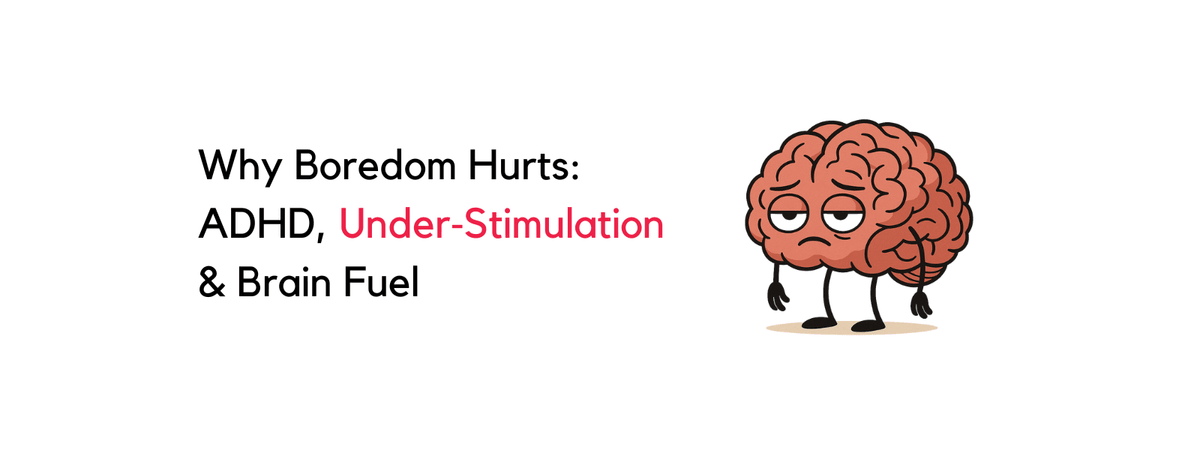Why Boredom Hurts: ADHD, Under‑Stimulation & Brain Fuel
Why Boredom Hurts: ADHD, Under‑Stimulation & Brain Fuel
Why Boredom Hurts: ADHD, Under‑Stimulation & Brain Fuel
Ever feel like boredom is more than just annoying?
For ADHD brains, boredom doesn’t just mean “nothing to do.” It can feel like mental quicksand; it’s foggy, frustrating, and even painful. That’s because ADHD isn’t just about distraction. It’s also about under‑stimulation.
In this post, we’ll explore what under‑stimulation really means, how it affects the ADHD brain, and what you can do to meet your mental energy needs without burning out.

What Is Under‑Stimulation in ADHD?
Under‑stimulation is not the same as being bored because you ran out of things to do. For ADHD brains, it’s a neurological mismatch between what your brain needs to feel engaged and what’s actually available.
This is linked to low-arousal theory, which suggests that ADHD brains operate with lower baseline arousal. That means we’re wired to seek external stimulation just to reach a “normal” level of alertness or focus. The result? A kind of “stimulus-hunger” that can make sitting still, doing repetitive tasks, or waiting feel unbearable.
And studies show people with ADHD report boredom more frequently and more intensely than neurotypical peers.
The Neurology Behind the Pain of Boredom
Let’s take a closer look at what’s happening under the hood, starting with the brain chemicals that shape how we feel, focus, and respond to boredom.
1. Dopamine Dysfunction
Dopamine is a key player in motivation, reward, and focus. ADHD brains have lower baseline dopamine, making it harder to stay interested in low-stimulation environments.
When dopamine dips too low, boredom sets in fast. This often drives the need to seek out stimulation, whether it’s through movement, noise, daydreaming, or impulsive behavior.
2. Norepinephrine’s Role
Dopamine doesn’t work alone. Norepinephrine, another neurotransmitter, helps with alertness and attention regulation. ADHD brains may also struggle with producing and distributing this chemical, making it even harder to maintain engagement.
What Boredom Feels Like with ADHD
If you've ever felt like boredom hits harder for you than it does for others, you're not imagining it. Here are a few ways to picture what’s going on inside an ADHD brain:
- Always on the Lookout for Stimulation
Your brain is wired to seek out novelty just to stay alert. Imagine your brain like a little radar dish, constantly scanning for something interesting. That’s what it feels like when you’re craving input. - The Burn of Boredom
When mental energy drops, it doesn’t just feel “dull.” It can feel agitating. Almost like there’s a fire burning inside your head that says, “Do something, anything!” - Your Stimulation Toolbox
Everyone with ADHD needs their own go-to tools. Think: a playlist that helps you focus, a fidget that keeps your hands busy, a window with natural light, or a timer that turns a task into a game. These aren’t distractions, they’re fuel.
These sensations can lead to impulsive behaviors, half‑finished projects, or chasing stimulation in unhealthy ways (think doom‑scrolling or snack attacks).
Why It Hurts More Than Just “Boring”
Let’s be clear: ADHD boredom isn’t a harmless yawn.
When the brain is under‑stimulated, it may:
- Wander into shame or guilt spirals
- Make more mistakes due to distraction
- Procrastinate important tasks
- Get stuck in emotional exhaustion
Boredom affects dopamine production in ADHD brains, which causes mind-wandering and executive errors.
Other consequences include missed deadlines, impulsive decisions, and frustration that gets wrongly interpreted as laziness.
Coping with ADHD Boredom: Strategies That Work
Here are a few ADHD-wired tools to help refuel your brain when under‑stimulation strikes:
Add External Stimulation
Music, white noise, fidgets, or ambient background noise can give your brain the extra stimulation it craves.
Gamify the Task
Use countdown timers, reward playlists, or race-the-clock games to build urgency and novelty.
Try Body Doubling
Work alongside someone else (in person or virtually) to stay engaged. The presence of another body can act as a stimulation anchor.
Build a “Stimulation Toolbox”
Keep a go-to set of tools ready for moments when boredom hits—like a sensory box, sketchpad, or upbeat playlist.
Shift Your Environmen
A change in scenery can jumpstart attention. Try working near a window, stepping outside, or adding natural light to your space.
Practice Grounding
Mindfulness and breathwork can train your brain to tolerate low-stimulation moments instead of fleeing them. Learn more ADHD movement strategies here.
Final Thought: It’s Not Laziness, It’s Neurochemistry
ADHD boredom is real and backed by brain science. You’re not lazy, flaky, or “bad at focusing.” Instead, you’re under-fueled. Knowing that gives you power.
So instead of blaming yourself for zoning out, start asking:
🧠 What does my brain need to feel alive right now?
Reframe, Reset & Rewire
Feeling scattered, foggy, or agitated? Try one stimulation-smart strategy today. It could be a song, a walk, or a 5-minute task race…and notice what changes.
And join the adhd i-os community on Instagram for daily tools, relatable tips, and support that truly gets how your brain works!

